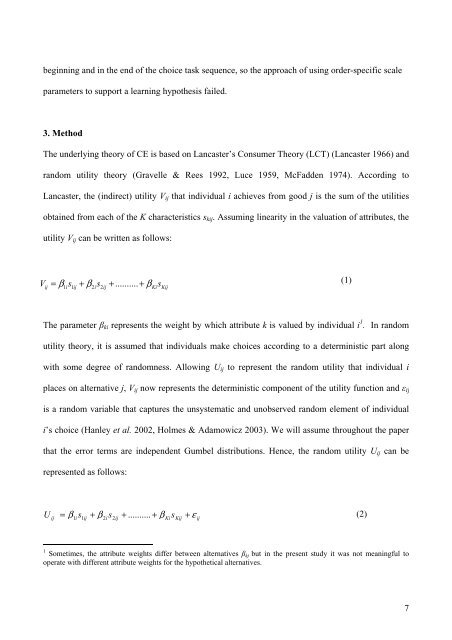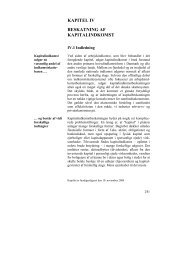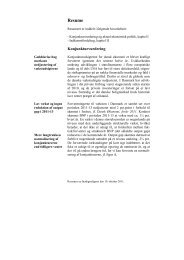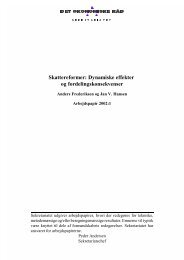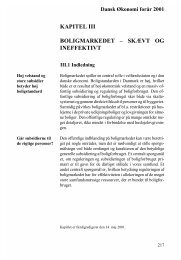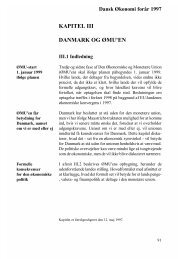The Effect of Learning and Fatigue on Preferences and WTP in a ...
The Effect of Learning and Fatigue on Preferences and WTP in a ...
The Effect of Learning and Fatigue on Preferences and WTP in a ...
You also want an ePaper? Increase the reach of your titles
YUMPU automatically turns print PDFs into web optimized ePapers that Google loves.
eg<strong>in</strong>n<strong>in</strong>g <str<strong>on</strong>g>and</str<strong>on</strong>g> <strong>in</strong> the end <str<strong>on</strong>g>of</str<strong>on</strong>g> the choice task sequence, so the approach <str<strong>on</strong>g>of</str<strong>on</strong>g> us<strong>in</strong>g order-specific scale<br />
parameters to support a learn<strong>in</strong>g hypothesis failed.<br />
3. Method<br />
<str<strong>on</strong>g>The</str<strong>on</strong>g> underly<strong>in</strong>g theory <str<strong>on</strong>g>of</str<strong>on</strong>g> CE is based <strong>on</strong> Lancaster’s C<strong>on</strong>sumer <str<strong>on</strong>g>The</str<strong>on</strong>g>ory (LCT) (Lancaster 1966) <str<strong>on</strong>g>and</str<strong>on</strong>g><br />
r<str<strong>on</strong>g>and</str<strong>on</strong>g>om utility theory (Gravelle & Rees 1992, Luce 1959, McFadden 1974). Accord<strong>in</strong>g to<br />
Lancaster, the (<strong>in</strong>direct) utility V ij that <strong>in</strong>dividual i achieves from good j is the sum <str<strong>on</strong>g>of</str<strong>on</strong>g> the utilities<br />
obta<strong>in</strong>ed from each <str<strong>on</strong>g>of</str<strong>on</strong>g> the K characteristics s kij . Assum<strong>in</strong>g l<strong>in</strong>earity <strong>in</strong> the valuati<strong>on</strong> <str<strong>on</strong>g>of</str<strong>on</strong>g> attributes, the<br />
utility V ij can be written as follows:<br />
V = β1s1 + β2 s2 + .......... + β s<br />
ij i ij i ij Ki Kij<br />
(1)<br />
<str<strong>on</strong>g>The</str<strong>on</strong>g> parameter β ki represents the weight by which attribute k is valued by <strong>in</strong>dividual i 1 . In r<str<strong>on</strong>g>and</str<strong>on</strong>g>om<br />
utility theory, it is assumed that <strong>in</strong>dividuals make choices accord<strong>in</strong>g to a determ<strong>in</strong>istic part al<strong>on</strong>g<br />
with some degree <str<strong>on</strong>g>of</str<strong>on</strong>g> r<str<strong>on</strong>g>and</str<strong>on</strong>g>omness. Allow<strong>in</strong>g U ij to represent the r<str<strong>on</strong>g>and</str<strong>on</strong>g>om utility that <strong>in</strong>dividual i<br />
places <strong>on</strong> alternative j, V ij now represents the determ<strong>in</strong>istic comp<strong>on</strong>ent <str<strong>on</strong>g>of</str<strong>on</strong>g> the utility functi<strong>on</strong> <str<strong>on</strong>g>and</str<strong>on</strong>g> ε ij<br />
is a r<str<strong>on</strong>g>and</str<strong>on</strong>g>om variable that captures the unsystematic <str<strong>on</strong>g>and</str<strong>on</strong>g> unobserved r<str<strong>on</strong>g>and</str<strong>on</strong>g>om element <str<strong>on</strong>g>of</str<strong>on</strong>g> <strong>in</strong>dividual<br />
i’s choice (Hanley et al. 2002, Holmes & Adamowicz 2003). We will assume throughout the paper<br />
that the error terms are <strong>in</strong>dependent Gumbel distributi<strong>on</strong>s. Hence, the r<str<strong>on</strong>g>and</str<strong>on</strong>g>om utility U ij can be<br />
represented as follows:<br />
U<br />
ij<br />
= β .......... +<br />
is<br />
ij<br />
+ β<br />
is<br />
ij<br />
+ + β<br />
KisKij<br />
ε<br />
(2)<br />
1 1 2 2<br />
ij<br />
1 Sometimes, the attribute weights differ between alternatives β kj but <strong>in</strong> the present study it was not mean<strong>in</strong>gful to<br />
operate with different attribute weights for the hypothetical alternatives.<br />
7


